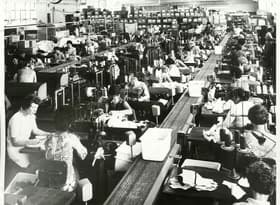Artificial Intelligence (AI) has been making headlines recently
ChatGPT, a chatbot launched in November 2022 by OpenAI and freely available to interact with on its website, has been making headlines with its ability to write code, poems, and even pass MBA exams. Some industry insiders even anticipate that ChatGPT will replace the ubiquitous Google search engine in just a couple of years. If nothing else, ChatGPT has brought AI to the front of many people’s minds, if it wasn’t there already.
AI has begun to be integrated into the workplace. But it is early days. In this article I look at the evidence to date on how AI will change the workplace, which skills AI is likely to automate, and what the limitations of AI are.
How will AI change the workplace?
Artificial intelligence (AI) is expected to have a significant impact on the workplace in the near future, leading to both new opportunities and challenges. Some of the ways AI is expected to change the workplace include the following.
- Automation of tasks: AI technologies such as machine learning algorithms and robotic process automation can automate routine and repetitive tasks, freeing up human workers to focus on higher-value tasks.
- Improved efficiency: AI can help organisations to streamline processes, reduce costs, and improve overall efficiency by analysing data, detecting patterns, and making predictions.
- Enhanced decision making: AI can provide organizations with valuable insights, helping them make data-driven decisions faster and more accurately.
- New job opportunities: While some jobs may be displaced by automation, new job opportunities will emerge in areas such as AI development, data analysis, and cybersecurity.
- Improved customer service: AI-powered ‘chatbots’ and virtual assistants can provide customers with faster and more personalized support.
However, the implementation of AI in the workplace may also raise ethical and societal concerns, such as job loss and unequal access to technology. It's important for organisations to approach AI adoption thoughtfully and consider the potential consequences for their employees and the wider community.
Defining AI is not easy
A recent OECD working paper entitled The impact of Artificial Intelligence on the labour market: What do we know so far? presents a useful literature review about the impact of AI on employment and wages, how AI will transform jobs and skill needs, and the impact on the work environment.
AI has been described as a General Purpose Technology (GPT), which is a technology that has potential application across a broad variety of sectors and occupations. Other examples of GPTs include computing, electrification, and the steam engine. What is perhaps unique about AI is its ability (through machine learning) to self-improve over time and generate innovations of its own. In fact, AI has been described as an ‘invention of a method of invention’. There is no widely accepted definition of AI but the OECD working paper uses the following.
“An AI system is a machine-based system that can, for a given set of human-defined objectives, make predictions, recommendations or decisions influencing real or virtual environments. It uses machine and/or human-based inputs to perceive real and/or virtual environments; abstract such perceptions into models (in an automated manner e.g. with machine learning (ML) or manually); and use model inference to formulate options for information or action. AI systems are designed to operate with varying levels of autonomy.”
This definition is admittedly a little abstract, and we expand on this thinking further in this article when we examine some of the existing applications of AI. What’s crucial here for considering AI’s effect on the workplace is its ability to make predictions, recommendations, or decisions influencing real or virtual environments based on inputs. The importance of inputs and modelling capability also helps us understand why developments in AI have been enabled by other technological developments such as big data, cloud computing, and machine learning.
AI is an unsettling development for many people
Hollywood has been making us anxious about AI for decades. As early as 1968, we were introduced to ‘Hal’, the terrifyingly deadpan AI in 2001: A Space Odyssey. The very popular Matrix and Terminator franchises both acquainted us with the idea that machine self-awareness could bring about humanity’s swift demise.
For some people, one of the unsettling things about AI is its ability to self-improve. Humans are accustomed to designing new technology and that technology doing what it is designed to do and no more. AI is designed to learn and develop. For many, this characteristic means that AI will one day lead to the singularity which describes a point in time at which machine intelligence exceeds human intelligence – essentially making humans redundant in the workplace.
AI also raises data privacy and protection issues. AI-enabled technologies rely on large data inputs. When employed in the workplace, there’s a reasonable chance these data inputs will cover worker behaviour and communications which inevitably leads to ‘big brother is watching you’ type concerns, especially if there is a lack of transparency about how these data are being used and how they influence decision making.
There are also concerns that AI can incorporate human bias either through human-designed algorithms, the data that is fed into AI systems, or the way that humans choose how the results of algorithms are used. Applying AI to recruitment processes are an example of how such biases might affect the workplace. AI can be used in the sourcing, screening, selection and offer phases of the hiring pipeline. But if AI is making its decisions and recommendations based on historical data and practises any previous bias may be baked into the process.
Based on what we know about AI and its implementation to date, the OECD offers a more nuanced view about its effects with AI able to surpass humans in the performance of certain cognitive tasks but coming up well short in other areas – as we detail below.
As such, AI is seen as a tool to augment human activity rather than a replacement for it. However, the OECD research shows that the drivers and context in which AI is adopted are crucial for determining its broader effects on workers.
Implementation of AI in workplaces is at an early stage
Early-stage adopters of AI include automotive assemblers, telecoms, transport and logistics, financial services, retail, and health services. AI is being used in settings as diverse as manufacturing process automation and improvement, visual (facial) recognition, conversational (chatbot) roles dealing with retail customer enquiries, health diagnoses, searching through legal texts, pilot training (in simulated environments), job search support, worker recruitment and other human resource management, teaching, driverless vehicles and climate change forecasting.
AI is well suited to non-routine cognitive tasks
AI can perform non-routine cognitive tasks such as problem solving, logical reasoning and perception capabilities. These kinds of tasks are currently done by highly skilled workers such as radiologists, lab technicians, engineers, lawyers, human resource professionals, and actuaries – to name but a few. The exposure of tasks in highly skilled roles to AI makes it different to many other automating technologies which to date have taken on more lower-skilled roles.
There are limits to what AI can (currently) do
However, creativity, social intelligence, empathy, dealing with uncertainty, utilising tacit knowledge developed through tradition and intuition, and good old ‘thinking outside the box’ are human skills that machines are a long way from replicating. AI is good at answering questions but is not suited to asking them.
Workers who successfully take advantage of AI will benefit most
AI’s limitations suggest that it will more likely complement and augment humans in the workplace rather than replace them. But there remains plenty of scope for displacement to occur. In the future labour market, AI will be combined with human creativity, judgment, and decision-making to create augmented intelligence. Jobs will be reorganised, and workers will need to reskill or upskill to use the new technology.
Perhaps most fundamentally, we humans will need to adapt to new ways of interacting with machines. To date, in manufacturing and warehousing environments, human-robot interaction has been limited due to the physical danger associated with humans and robots sharing the same space. AI offers the potential for these safety risks to be reduced and possibly eliminated, as robots with AI-assisted intelligent navigation systems are better able not only to respond safely to humans operating in close proximity but to work in collaboration with them.
For most of us, tapping on a screen or pointing and clicking with a mouse are second nature. In future, speaking to machines will become commonplace and will feel very much like interacting with a human. Perhaps more challenging for some people is the potential for AI to act as a team leader or manager allocating tasks to human team members. Certainly, an increasing number of roles will require workers to use information produced by AI technologies in their decision making.
Productivity improvements of AI may take time
AI is expected to increase workplace productivity by augmenting and complementing both human activity and existing technology in the workplace. But the OECD report that so far, implementation of AI to date has not led to significant productivity improvements. In fact, productivity growth has been lagging in the past decade despite substantial progress in AI – something which is referred to as the productivity paradox.
Productivity gains might simply take time to materialise. There could be several reasons for this lag between adoption and (measurable) productivity increases. Early adopters might be implementing the wrong kinds of AI. There may be a lag between implementation and productivity growth as businesses need time to restructure their operations around the new technology to fully benefit from it. In fact, there’s likely a higher up-front cost to AI, with time and resources needing to be front-loaded now to get AI-related processes underway, with benefits taking time to appear. And productivity gains might only be accruing to a small number of firms who have so far adopted the technology. There are also questions around whether productivity statistics can fully capture gains from AI and other digital technologies.
The broader effects of AI depend on many things
The effect of AI on employment, wages, and the work environment in general is even harder to predict because it depends on a wide range of factors. These factors, include what type of AI is adopted, why it is adopted (for increasing worker safety, cost cutting, worker performance monitoring, innovation), how fast it is adopted, how it is deployed (worker replacement or worker augmentation), market conditions and government policy.
For example, if AI is adopted to replace workers in strenuous or hazardous work environments, it can reduce worker health and safety risks. If AI is adopted to monitor and raise worker performance, it could lead to greater stress and potentially burnout if done excessively.
Economic studies naturally tend to focus on existing tasks that AI can perform better than humans. It is much harder to predict what entirely new, labour-intensive tasks and roles will be created as a result of the adoption of AI, and how long they will take to materialise.
One concerning scenario is that of first mover advantage, where a country or a firm gains a significant competitive advantage from being the first to adapt AI. Moving first could enable them to monopolise their market, leading to mass job losses in other firms or countries. It’s hard to anticipate the probability of this outcome happening. But it seems to presuppose a point at which an AI system suddenly becomes better than any other technology available. The incremental nature of AI technological development seems at odds with this ‘winner takes all’ scenario.
Ultimately, the extent to which an economy enables workers to benefit from AI productivity gains through higher wages will go a long way to determine how the benefits of AI are shared between workers, business owners and shareholders. The availability and quality of education, training and job-search infrastructure that enables displaced workers to easily transition into different jobs will be a key determinant in how well the transition period is managed with workers needing to upskill, reskill and/or change as AI adoption diffuses through the economy.
Looking at the bigger picture, it’s hard to worry about AI bringing about mass unemployment when we are facing global labour and skill shortages that will only intensify as the population ages.
A useful tool or a competitor?
I started writing this article by asking ChatGPT: How will AI change the workplace? Its eloquent and informative answer is in the paragraph under the same title. I’m not quite ready to hang up my boots but I can already see the potential for AI to perform some of my day-to-day tasks as an economic consultant.
Technology can be a tool or a competitor. To improve productivity, we need to allow technology to do what it’s better at than us. We already use computers to store large amounts of data that no human being could possibly remember, and to carry out millions of calculations faster than any human could. AI is just another step further along a path we have been on for decades, if not centuries.
















